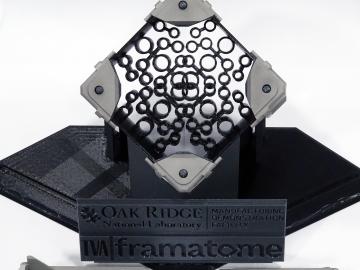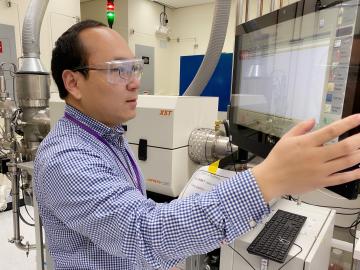
Filter News
Area of Research
- (-) Advanced Manufacturing (14)
- (-) Building Technologies (1)
- (-) Fusion and Fission (4)
- (-) Materials (30)
- Biology and Environment (19)
- Computational Engineering (1)
- Computer Science (3)
- Energy Science (57)
- Fusion Energy (1)
- Materials for Computing (5)
- National Security (8)
- Neutron Science (5)
- Nuclear Science and Technology (6)
- Quantum information Science (2)
- Supercomputing (23)
News Type
News Topics
- (-) 3-D Printing/Advanced Manufacturing (25)
- (-) Big Data (2)
- (-) Composites (9)
- (-) Microscopy (12)
- (-) Molten Salt (1)
- (-) Partnerships (3)
- Advanced Reactors (5)
- Artificial Intelligence (5)
- Bioenergy (5)
- Biomedical (5)
- Buildings (5)
- Chemical Sciences (12)
- Clean Water (3)
- Computer Science (11)
- Coronavirus (2)
- Critical Materials (5)
- Cybersecurity (1)
- Education (1)
- Energy Storage (14)
- Environment (9)
- Exascale Computing (2)
- Frontier (1)
- Fusion (18)
- Grid (2)
- High-Performance Computing (3)
- Isotopes (8)
- ITER (4)
- Machine Learning (2)
- Materials (37)
- Materials Science (39)
- Mathematics (1)
- Nanotechnology (16)
- Neutron Science (15)
- Nuclear Energy (29)
- Physics (13)
- Polymers (10)
- Quantum Computing (2)
- Quantum Science (1)
- Security (2)
- Simulation (2)
- Space Exploration (3)
- Summit (1)
- Transportation (11)
Media Contacts

Oak Ridge National Laboratory researchers have demonstrated that a new class of superalloys made of cobalt and nickel remains crack-free and defect-resistant in extreme heat, making them conducive for use in metal-based 3D printing applications.

The ExOne Company, the global leader in industrial sand and metal 3D printers using binder jetting technology, announced it has reached a commercial license agreement with Oak Ridge National Laboratory to 3D print parts in aluminum-infiltrated boron carbide.

The Transformational Challenge Reactor, or TCR, a microreactor built using 3D printing and other new advanced technologies, could be operational by 2024.

About 60 years ago, scientists discovered that a certain rare earth metal-hydrogen mixture, yttrium, could be the ideal moderator to go inside small, gas-cooled nuclear reactors.

From materials science and earth system modeling to quantum information science and cybersecurity, experts in many fields run simulations and conduct experiments to collect the abundance of data necessary for scientific progress.

Oak Ridge National Laboratory researchers have built a novel microscope that provides a “chemical lens” for viewing biological systems including cell membranes and biofilms.

Scientists at the Department of Energy Manufacturing Demonstration Facility at ORNL have their eyes on the prize: the Transformational Challenge Reactor, or TCR, a microreactor built using 3D printing and other new approaches that will be up and running by 2023.

In the race to identify solutions to the COVID-19 pandemic, researchers at the Department of Energy’s Oak Ridge National Laboratory are joining the fight by applying expertise in computational science, advanced manufacturing, data science and neutron science.

Scientists at Oak Ridge National Laboratory used a focused beam of electrons to stitch platinum-silicon molecules into graphene, marking the first deliberate insertion of artificial molecules into a graphene host matrix.

Liam Collins was drawn to study physics to understand “hidden things” and honed his expertise in microscopy so that he could bring them to light.


